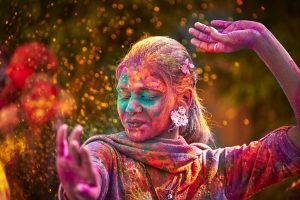
Portrait Of Young Indian Woman With Colored Face Dancing During Holi – Thanks to Tri-Valley for the picture
Holi is a Hindu festival of radiance and celebration of spring with colors that nourish one’s happy moods and complements the function of respective elements in the atmosphere. The essence of Holi is liberation and breaking the barriers between adults and children, family members, and friends, and the festivity opens up to each other.
Although Holi is part of the Hindu tradition, most Indians participate in it, it presents the unity of Hindus, Muslims, Sikhs and Christians and of course, Jains, Zoroastrians, Baha’i, Jews, Buddhist, and native traditions. You can read more about it at https://centerforpluralism.com/happy-holi/
“Festivals of the World” is an educational series commenced by Mike Ghouse in 1993. When we live in the same communities as neighbors, we might as well learn about each other. The best way to build cohesive societies is for its members to participate in festivities as well as commemorations of each other, or, at least understand each other’s’ joys and sorrows. For the believers, the events have religious connotations, but for others, it should be a cultural event, where their friends join them as friends to celebrate or commemorate, this is what builds relationships and bonding and eventually safe societies.
I am proud of the pluralistic heritage of India. Over the last thousand years, Hindus, Muslims, Christians, Buddhists, Jains, and Jews have done everything to be a part of each other and yet have retained their identities. The society has developed a common culture; however, to the shameful exclusion of Dalits and Adivasis, who are considered inferior humans; it is repulsive to think that such attitudes exist even now.
Much work is done to correct thousands of years of DNA’d attitudes of the caste system; this disgusting practice needs to go. We are talking about human dignity and respect the God-given the uniqueness of each one of us. Thanks to Mahatma Gandhi and Dr. Ambedkar and thousands of Indians for taking up the issue to correct the wrongs of yesteryears. My father was bold enough to break the norms and invited the Dalits in our home to share tea or a meal with us, and eating from the same utensils that we used, and I fought vigorously at the street corner water taps to give equal access to the Dalits.
A foreigner visiting India cannot tell who is a Muslim, Hindu, Christian, Dalit , Sikh, Jain, Buddhist, Bahai or a Jew. We all look the same, dress the same and pretty much eat from the same range of foods. If you visit a park, beach, tomb, a touristy place, restaurant, and a theater, you will find all of them enjoying the activity together; you cannot differentiate who is who.
However, the filthy politicians continue to pit one Indian against the other, nothing different than the US or any other nation. There was a time, such divisive tricks did not work with the people, and even now, it does not work with a majority of Hindus, Muslims, and Christians.
Devotional songs are a part of every Indian, including Atheist, they all enjoy the tunes. As a Muslim I have participated in the religious songs of all religions, they sound beautiful, and the essence of all of them is to express gratitude to the creator.
Even though the film Padamavat has portrayed King Alauddin Khalji as a crude lustful man, he is no different from the kings of the past or the leaders of today. What is essential is Khalji was shown giving utmost respect to the festival of Holi, by having one his attendants place symbolic colors on his face. There are innumerable stories among Kings and the commoners of yesteryears, and another example was King Aurangzeb protected a Hindu queen because she ties a Rakhee (symbolic of sister’s love for brother). There was, and still tremendous respect for each other’s traditions.
Muslims and vice versa write some of the most beautiful Hindu and Sikh devotional songs. The most famous Indian poetry includes references to the multiple religious points – for example in the film Pyasa, there was a song called, “Jinhein naaz hai hind per o Kahan Hain,” and in one of the lines the poet brings in two different faiths commonness; the status of a woman; A Radha ki hamjins, a hawwa ki beti.”
This week incredible poetry of such syncretism has appeared. This was written some 300 years ago, and the poet Bulleh Shah has beautifully merged the Islamic tradition with the Hindu tradition.
Dr. Mike Ghouse is committed to building cohesive societies and offers pluralistic solutions on issues of the day. His new book, the “American Muslim Agenda” is about everything you wanted to know about Muslims. The book is available at Amazon, Barnes and Noble and Kindle. Mike is a public speaker, author, interfaith wedding officiant, a newsmaker and the executive director of the Center for Pluralism in Washington, DC. More about him in three formats at https://www.linkedin.com/in/mikeghouse/
